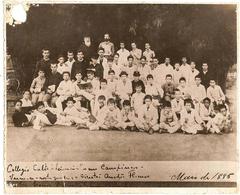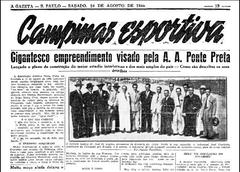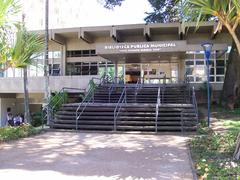
Fazenda Santa Genebra: Visiting Hours, Tickets, and Attractions in Campinas, Brazil
Date: 03/07/2025
Introduction
Fazenda Santa Genebra, located in Campinas, São Paulo, is a unique destination where history, culture, and nature converge. Established in 1799 as part of the Portuguese sesmaria land grant system, it has evolved from a large coffee plantation into one of the most significant ecological reserves in the region. Today, it preserves a vital portion of the Atlantic Forest, offers educational programs, and stands as an emblem of Campinas’ commitment to environmental conservation and historical preservation. This guide presents detailed information on visiting hours, ticketing, accessibility, tour options, and nearby attractions to help you make the most of your visit. For the most recent updates or changes, always consult the Fundação José Pedro de Oliveira’s official website and social media channels. (Fazenda Santa Genebra History, Fundação José Pedro de Oliveira, Wikipedia)
Historical Overview
Colonial Foundations (1799–1849)
Fazenda Santa Genebra’s story begins with the 1799 sesmaria grant to Francisco Antônio de Souza, initially known as Fazenda Morro Grande. The estate played a pivotal role in developing São Paulo’s agricultural landscape during Brazil’s colonial period, passing through generations and reflecting the social structures of the time. (Fazendas Antigas)
Transformation and Renaming (1863–1876)
After Genebra Miquelina de Sousa Queiroz—whose name the estate now bears—passed away in 1863, the property was managed and renamed by the Marquesa de Valença. The estate’s agricultural operations during this period relied heavily on enslaved labor, which continued until the abolition of slavery in 1888.
The Barão Geraldo Era (1876–1907)
Under the stewardship of Geraldo Maria Ribeiro de Sousa Rezende, or Barão Geraldo de Rezende, the estate entered its golden age. Spanning over 3,000 hectares, it became a hub of agricultural innovation, introducing new techniques and expanding coffee production. The estate’s prosperity shaped the development of modern neighborhoods in Campinas, such as Santa Genebra and Vila Nova. (Morando em Barão)
Agricultural Evolution and Research (20th Century)
Transitioning from coffee to cotton in the 1930s, Fazenda Santa Genebra also became a center for agricultural research. The Instituto Agronômico de Campinas (IAC) used its fields to develop hybrid crops, furthering the estate’s legacy of innovation.
Modernization and Conservation (1935–Present)
Managed by the Osório de Oliveira family from 1935, the estate diversified its production and adapted to Campinas’ urban expansion. In 1981, a significant portion of the land, including its forest, was donated to the city with a unique legal covenant to ensure perpetual preservation. Since 1990, the Mata da Fazenda Santa Genebra has been a protected reserve, safeguarding biodiversity and serving as a community and scientific resource. (Wikipedia)
Visiting Information
Location and Access
- Address: Rua Mata Atlântica, 447, Bosque de Barão Geraldo, Campinas, SP, Brazil.
- Accessibility: Easily reachable by car (with parking available) or public transport from downtown Campinas.
- Registration: All visits must be pre-registered through the Fundação José Pedro de Oliveira website for self-guided tours. Groups of more than 10 must book a guided tour (group registration link).
Visiting Hours
- Tuesday to Sunday: 8:00 AM – 5:00 PM
- Closed: Mondays and public holidays
- Note: Hours may vary seasonally. Confirm before your visit on the official website.
Tickets and Fees
- General Entry: Free (registration required for all visitors)
- Guided Tours: Advance booking necessary; no additional fee but subject to availability
- No physical tickets are issued; confirmation email from registration serves as entry proof.
Facilities and Accessibility
- Trails: Well-marked paths of varying lengths and difficulty, suitable for most visitors. Some areas are wheelchair accessible, though natural terrain may limit access in certain spots.
- Visitor Center: Includes restrooms, exhibition space, water fountains, and environmental education rooms.
- Picnic Areas: Designated spots available; bringing your own food is allowed.
- Safety: Staff and security cameras are present throughout the reserve.
Experiences and Attractions
Trails and Biodiversity
Mata de Santa Genebra covers 251.77 hectares and protects one of the largest remaining fragments of Atlantic Forest in São Paulo’s interior. The reserve is home to over 660 plant species and 365 vertebrate species, including the puma (onça-parda), ocelot (jaguatirica), red howler monkey (bugio-ruivo), and many rare birds. Interpretive signs along trails offer insights into the region’s flora and fauna. (Portal On)
Guided and Educational Visits
The Fundação José Pedro de Oliveira organizes guided tours for groups, schools, and philanthropic entities, focusing on ecology, history, and conservation. Educational workshops and seasonal events—such as the FEIRATA community fair—are regularly held. (FJPO Official Site)
Research and Conservation
The site serves as a living laboratory for ecological and environmental research, collaborating with institutions like UNICAMP. Scientific projects, restoration efforts, and citizen science initiatives are ongoing.
Nearby Attractions
- Instituto Agronômico de Campinas (IAC): Pioneer in Brazilian agricultural research.
- Barão Geraldo Neighborhood: Offers local dining, artisan markets, and cultural venues.
- Butterfly House and Meliponary: On-site educational attractions.
Rules and Visitor Conduct
- Stay on marked trails to protect habitats.
- No collection of plants, animals, or natural materials.
- Pets are prohibited to avoid wildlife disturbance.
- No fires or smoking—risk of forest fires is high.
- Carry out all trash; recycling bins are available.
- Do not feed the wildlife.
- Professional photography and research require prior authorization.
Violations may result in removal from the reserve and legal action.
Practical Tips for Visitors
- Pre-register online—this is mandatory for all visitors.
- Check weather conditions—wear suitable clothing and footwear, especially in rainy months (October–March).
- Bring water, snacks, sunblock, and insect repellent.
- Arrive early for the best wildlife sightings and to enjoy cooler temperatures.
- Download maps and check for any alerts on the official website.
Frequently Asked Questions (FAQ)
Q: What are the visiting hours?
A: Tuesday to Sunday, 8:00 AM – 5:00 PM (closed Mondays and holidays).
Q: How do I book my visit?
A: Register via the FJPO website.
Q: Is there an entrance fee?
A: No, entry is free but advance registration is necessary.
Q: Are pets allowed?
A: No, pets are not permitted.
Q: Are guided tours available in English?
A: Most tours are in Portuguese; contact ahead for possible arrangements in English.
Q: Is the reserve wheelchair accessible?
A: Main trails and facilities are mostly accessible, but some terrain may be challenging.
Q: Can I have a picnic on site?
A: Yes, use designated picnic areas.
Q: How do I get there by public transport?
A: Bus lines from Campinas city center serve the Barão Geraldo district; check local schedules.
Campinas: Historical and Cultural Context
Campinas is a dynamic city known for its colonial roots, coffee-era prosperity, and progressive urban planning. Founded in 1774, its economic rise was driven by agriculture and later by industry and technology. Estates like Fazenda Santa Genebra played crucial roles in its evolution, leaving an enduring legacy in the city’s neighborhoods and green spaces (HikersBay).
Today, Campinas is recognized for its parks, gardens, and commitment to sustainability. The Barão Geraldo district, home to Fazenda Santa Genebra, is a vibrant area blending academic institutions, residential communities, and preserved natural spaces. The city’s efforts to balance heritage conservation with modern development make it a model of urban stewardship.
Other notable attractions in Campinas include Parque Portugal (Lagoa do Taquaral), Museu de História Natural, and the Centro de Convivência Cultural. These sites, alongside Fazenda Santa Genebra, offer a comprehensive experience of the city’s historical and natural wealth (HelloTravel).
Final Tips and Key Takeaways
Fazenda Santa Genebra stands as a testament to Campinas’ rich history and ecological commitment. Whether you are a nature enthusiast, history buff, or cultural traveler, the reserve offers accessible trails, engaging educational programs, and a chance to witness rare Atlantic Forest wildlife. By respecting conservation guidelines and participating in available tours and workshops, you support the ongoing preservation of this invaluable heritage.
For the latest information, registration, and event updates, visit the FJPO Official Site, and follow their Instagram and Facebook pages.
Plan your visit, explore Campinas’ historical gems, and be a part of preserving this extraordinary natural and cultural landmark.
Official Resources and Further Reading
- Fazenda Santa Genebra Official Website
- Fundação José Pedro de Oliveira – Visitor Information
- Mata de Santa Genebra Wikipedia
- HelloTravel: Mata de Santa Genebra Guide
- Portal On: Biodiversity and History
- Morando em Barão: Estate History
- HikersBay: Campinas Tourist Information
All information is accurate as of 2024; visitors are encouraged to verify details before planning their trip.







